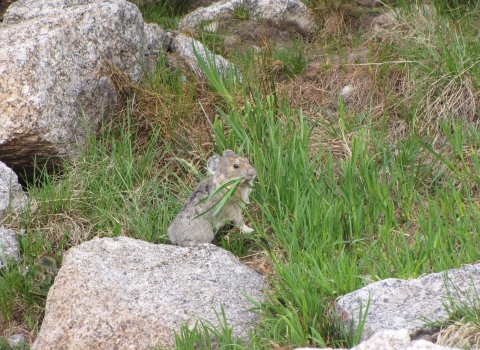Every year more than one billion birds collide with glass in the U.S. alone! While most fatal collisions happen at homes and buildings shorter than four stories tall, smaller structures like glass walkways and bus stop shelters also pose a threat.
Why do birds collide with glass?
To birds, glass is an invisible, deceiving threat. Since they cannot see glass the way we do, they do not treat it as a barrier to avoid. Instead, they can be attracted closer to the reflections in glass that show what could appear to be elements of their natural habitat, such as plants and open sky. Birds can also collide with windows when they are attracted to landscaping outside the window or lights shining out from the interior. Sadly, while many birds that collide with windows may seem fine at first, most later die from traumatic injuries.
The good news is, these collisions are preventable, and there are many ways we can make our homes and buildings safer for birds! Even better, many of the solutions come with added benefits, such as new aesthetic designs and reduction in energy use and costs!
So, How Can You Help?
Dress Up Your Windows
Patterns can be applied to the outside of windows to help birds see that glass is there. These patterns should be ¼-inch in diameter (or larger) and be placed no more than 2 inches apart from each other. Spacing patterns in a 2" x 2" grid is especially important for protecting small birds like hummingbirds. Dark colored patterns can be difficult for birds to see when the window reflects dark colors, so it can be best to use medium to light colors for visibility.
Parachute cord curtains cost approximately 11 cents per square foot. This elegant, inexpensive option uses 1/8-inch paracord pieces spaced less than 4 inches apart, hanging outside from the top of the window. The paracord creates a visual barrier for birds. These curtains can be purchased pre-made or constructed with relatively inexpensive and readily available materials.
Tempera paint costs 13 cents per square foot. Using the 2" x 2" spacing mentioned above, non-toxic tempura paint patterns or artwork applied to exterior glass can reduce bird collisions for many years. Tempura paint is easily removed using vinegar and water. This can be a fun activity to do with family, friends or even in a class with students!
Screens and netting cost about $1.83 per square foot. External insect screens reduce bird collisions by reducing window reflections and alerting birds that windows are barriers. Netting prevents injuries to birds if the bird can safely bounce off the screen instead of hit the hard glass. Net openings should be 1/2-inch or smaller, so birds don’t become caught. Screens can be attached with suction cups or eyehooks.
Tape, decals, and external films cost $2.50 (tape), $8-12 (dot patterns), and $4-6 (film), all per square foot. Products are available in many colors, tints, and patterns.
Choose Bird Friendly Glass
Acid-etched, Fritted or Frosted Glass
Most effective when on the glass exterior, “fritted” glass includes adhered ceramic lines, dots or other patterns. Etching, fritting, and frosting not only reduce the risk of bird collisions but also reduce energy costs by reducing solar heat gain (27 SHGC) and reducing cooling loads. You can save energy and birds while still naturally lighting your buildings. Existing glass can be frosted using sandblasting. The American Bird Conservancy provides the latest recommendations in glass products and techniques.
Ultraviolet Patterned Glass
Ultraviolet (UV)-reflecting glass products are available with patterns generally invisible to humans but visible to many birds species. The American Bird Conservancy provides the latest recommendations in glass products.
Channel Glass
Patterns created by channel glass reduce bird collisions and is made of energy efficient, recycled materials. The American Bird Conservancy provides the latest recommendations in glass products.
Reduce Lights at Night
Lastly, one of the simplest actions we can take has less to do with the glass and more to do with our lights! Though birds collide with glass all throughout the year, it happens the most when they are on the move during spring and fall migration. Most birds migrate at night, making them more vulnerable to buildings and other structures lit with artificial lights they might be attracted to, often resulting in tragic collisions, entrapment, and exhaustion.
Minimizing artificial lights at night can make a difference for birds, pollinators, and even us humans who like to see the starry night sky! Turning off unneeded lights by hand or using timers and motion sensors can not only lessen bird attraction to glass, but can also reduce energy costs and light pollution overall. Using blinds, shades, awnings and shutters in windows can also reduce the amount of light that escapes in or out and help birds see the glass as a barrier.
Visit our page on nighttime lighting to learn more about how you can implement bird-conscious lighting techniques at your location. These techniques can also be used on offshore vessels and structures, where birds that migrate or forage over seas are also affected and disoriented by nighttime lighting.
Bird Collision Reduction Toolkits
BIRD-FRIENDLY BUILDING TOOLKIT
BIRD-FRIENDLY UNIVERSITY TOOLKIT
BIRD-FRIENDLY COMMUNICATION TOWER TOOLKIT
DEVELOPING A BIRD-GLASS COLLISION MONITORING PROGRAM
Podcast on Collisions by USFWS/NCTC on Collisions - Birds in Flight: Migration and Its Perils







